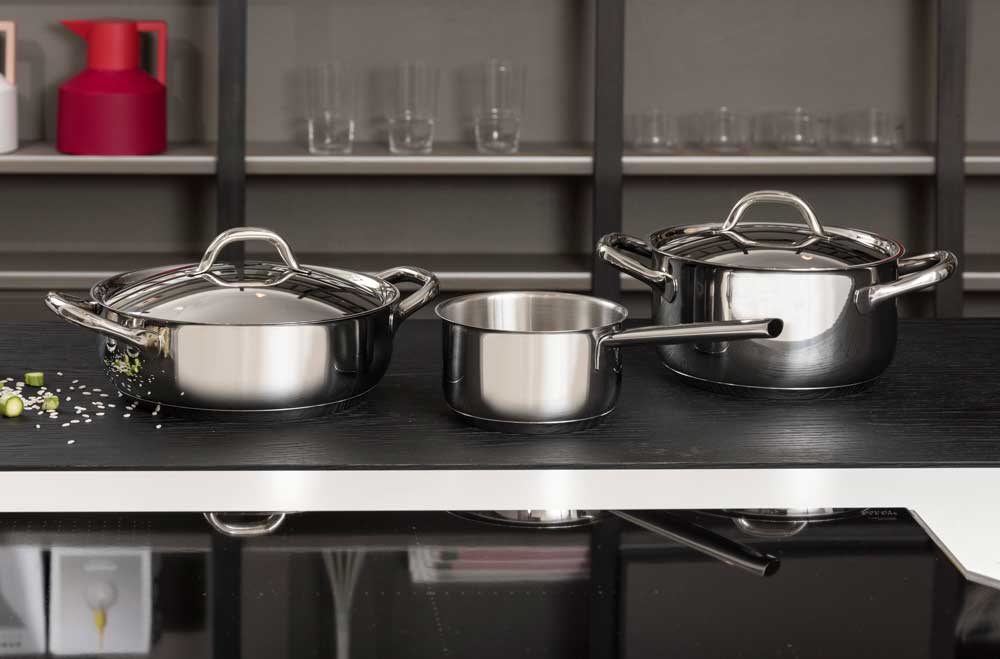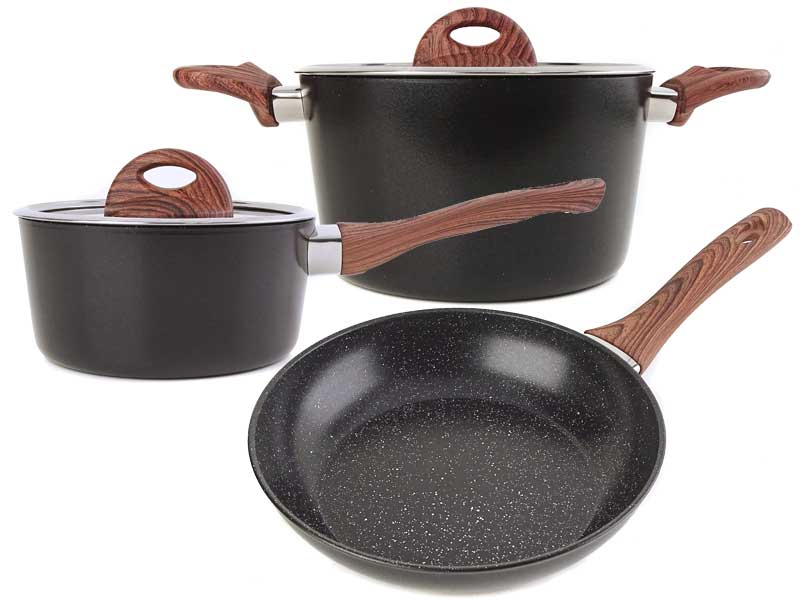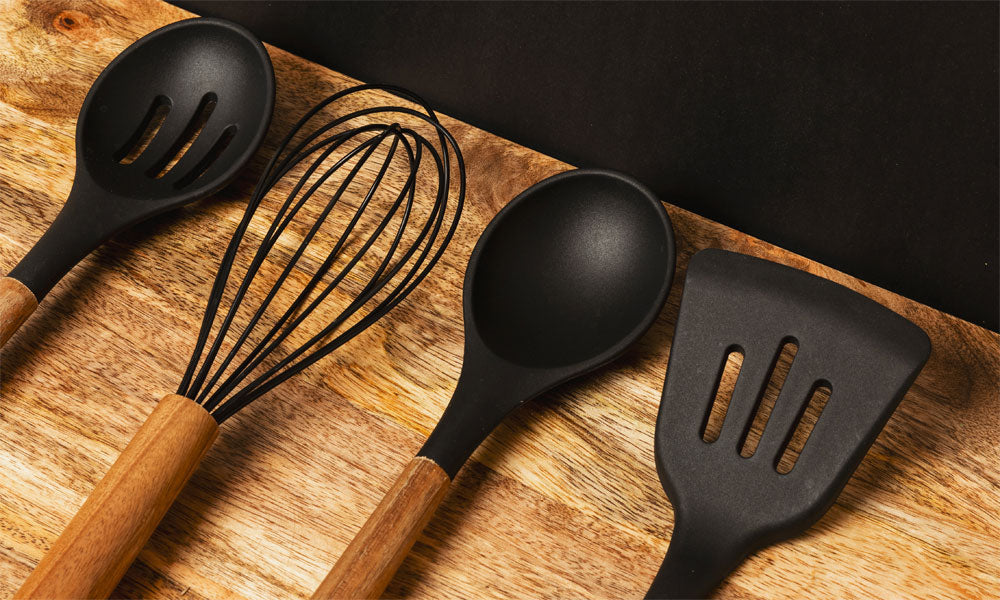measurements and sizes
Measure the size, height, diameter and capacity of a pan, pot and roaster correctly
When choosing the size of pans and pots, there are always questions and misunderstandings regarding the size specifications. Here you can find out what the information on diameter, height, base diameter and capacity mean and how to measure correctly.
The most important information: diameter = upper inner diameter

The diameter is the most important indication of the size of pots and pans. The measurement is taken at the top inside , i.e. on the inside of the pan/pot rim; hence the designation upper inner diameter, which you will find in our item descriptions. A 28 cm pan has a diameter of 28 cm from one inner edge to the other inner edge. This measurement method is an international standard and is authoritative unless expressly stated otherwise in the item description. The overall diameter of the pan or pot depends on the thickness of the rim and is therefore unsuitable for sizing!
Only by classifying them according to the upper inner diameter is it at least approximately guaranteed that, for example, a 28 cm lid of "28 cm pan A" with a thin rim also fits a "28 cm pan B" with a thick rim.
The most common sizes for pans and pots are 16, 20, 24, 28, 32 cm. Depending on the country, intermediate sizes such as 14, 22, 26 and 30 cm are also common.
Size of square pans & roasters

For square pans (e.g. many grill pans) and roasters, the size is given as the product of two lengths. Here you measure again at the top inside, at the longest point, which is usually in the middle. For example, many grill pans have a size of 28 x 28 cm.
Size of oval pans & roasters
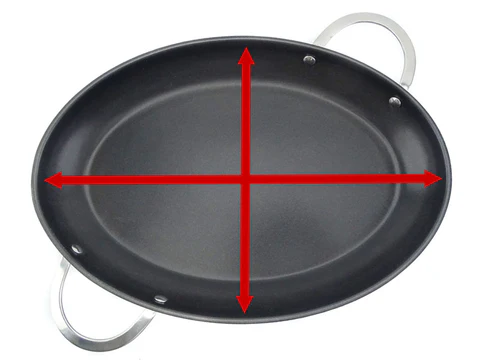
Fish pans and roasters often have an oval shape. As shown above with the square pans, the longest internal dimension is given here. Such a 38 cm fish pan has an inner length of 38 cm on its longest side. At right angles to this is the short side of eg 24 cm. As a result, the pan would be declared as 38 x 24 cm.
Bottom diameter = contact surface
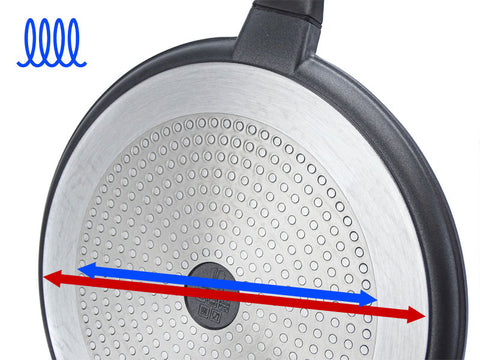
When we talk about base diameter, we mean the diameter of the contact surface, i.e. the surface with which the pan, pot or roaster stands on the stove. Not meant is the frying surface! The information about the base diameter can be helpful when it comes to choosing a suitable cooking zone for the cookware. The size of the hotplate and the diameter of the base of the cookware should match to a certain extent in order to avoid damage to the cookware and to ensure that the cookware functions as well as possible.
Base diameters, like hotplates/cooking zones, are not standardized , so that the base diameter of "28 cm pan A" can be 23.5 cm, for example, but that of "28 cm pan B" is only 20.7 cm.
ATTENTION, induction-suitable aluminum cookware:
Please note that cookware made of aluminum / cast aluminum for induction cooking usually has a stainless steel disc on the base, the diameter of which is often smaller than that of the base (marked in blue in the picture). Where this applies, you will find the corresponding information in our item descriptions.
frying surface of a pan

Perhaps you have already noticed that pans of the same diameter have different sized frying surfaces. This surface describes the usable flat bottom area of a pan without the convex pan wall. A 28 cm pan with a strongly curved side wall naturally has a smaller frying surface than a frying pan with a more straight, vertical side wall. A specific indication of the size of the frying surface is unusual, also because the transition from the bottom to the side wall is often very gentle, so that it would be difficult to give an exact figure. In most cases, however, you can easily use the base diameter (the contact surface on the stove) of the cookware as a guide.
height of pots and pans

Unless expressly stated otherwise, the indication of the height of a cookware describes the outer edge height, from the top edge of the cookware perpendicularly to the contact surface, without taking lids, handles etc. into account.
The inner height (i.e. from the frying surface up to the edge) can be determined approximately by subtracting the base thickness from the height.
Capacity of a cookware

When it comes to capacity, there are often misunderstandings: the capacity of a cookware indicates how much the container can hold at most. That always means filling up to the brim! This is international standard.
The filling quantity that can be used when cooking is always less than the capacity , depending on the liquid and cooking intensity more or less. However, since this is the case with all cookware, comparability is maintained when using the capacity as a standard of comparison.
A practical example of the difference between capacity and filling quantity used: Let's assume we have a pot with a declared capacity of 4 liters. For quiet simmering / simmering, this can perhaps be filled up to a thumb's width below the rim with, for example, 3.5 liters. However, the same filling quantity is too much for intensively bubbling cooking, you would not fill in more than 3 liters so that it does not boil over. And if the cooking water foams when you cook the pasta? A filling with only 2.5 liters could be too much. So is it now a 2.5 liter pot? Or a 3.5 liter pot? No, the only meaningful information is the maximum capacity in terms of filling to the brim. This is the only way to compare!
Filling quantities for pressure cookers:
Please note that in the case of pressure cookers, for safety reasons, the fill level permitted in pressure cooking is significantly lower than the capacity of the pot. A 6 liter pressure cooker usually has a maximum capacity of about 4 liters. Please note the information in the item description and the maximum mark, which you will usually find on the inside of the pot.


